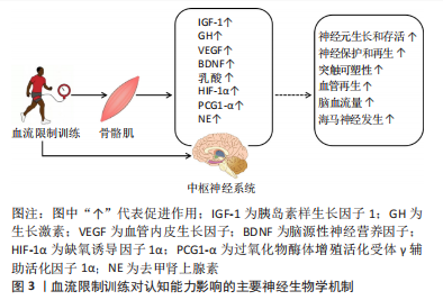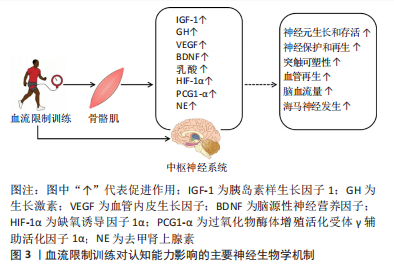Chinese Journal of Tissue Engineering Research ›› 2023, Vol. 27 ›› Issue (28): 4577-4585.doi: 10.12307/2023.813
Previous Articles Next Articles
Improvement of cognitive function by blood flow restriction training: mechanisms and applications
Bai Xing1, 2, Wang Guojun1, 2, Wang Shaokun1, 2
- 1Physical Education College of Hunan University of Technology, Zhuzhou 412000, Hunan Province, China; 2Hunan Provincial Key Laboratory of Physical Health and Fitness, Zhuzhou 412000, Hunan Province, China
-
Received:2022-10-20Accepted:2022-11-25Online:2023-10-08Published:2023-01-29 -
Contact:Wang Guojun, PhD, Associate professor, Master’s supervisor, Physical Education College of Hunan University of Technology, Zhuzhou 412000, Hunan Province, China; Hunan Provincial Key Laboratory of Physical Health and Fitness, Zhuzhou 412000, Hunan Province, China -
About author:Bai Xing, Master candidate, Physical Education College of Hunan University of Technology, Zhuzhou 412000, Hunan Province, China; Hunan Provincial Key Laboratory of Physical Health and Fitness, Zhuzhou 412000, Hunan Province, China -
Supported by:Hunan Provincial Key Laboratory Open Research Program, No. TZJK-202105 (to WGJ)
CLC Number:
Cite this article
Bai Xing, Wang Guojun, Wang Shaokun. Improvement of cognitive function by blood flow restriction training: mechanisms and applications[J]. Chinese Journal of Tissue Engineering Research, 2023, 27(28): 4577-4585.
share this article
Add to citation manager EndNote|Reference Manager|ProCite|BibTeX|RefWorks

2.1 血流限制训练对认知功能的影响 血流限制训练是指在训练过程中通过特殊加压装置对人体的四肢进行加压,调节血液流向,短暂限制动脉和静脉血液流动,从而使肢体远端部分血液淤积造成局部缺血,进而增加运动诱导的训练效果,即局部“低氧刺激”效果[9]。该种方法最初于1966年由日本佐藤义昭博士验证,并在1988年后陆续投入使用[10],近20年来更成为研究者普遍关注的热点,其旨在采取独特运动训练手段使人们在限制肢体部分血液流动且能够完成预期负荷强度运动的同时得以增加肌肉大小和力量[11]。血流限制训练通过物理加压手段使人体产生局部机械压力代谢补偿危机,从而诱导大脑、骨骼肌分泌激素促进代谢,进而加强组织修复能力,最终达到提高身体机能的效果。在实际操作过程中,通常将20%-30% 1RM作为血流限制训练联合低强度抗阻训练的常规负荷,以此达到与中高强度负荷训练相似的效果[12]。随着研究的不断深入,逐渐有学者发现血流限制训练可诱导较广泛人群肌肉和心血管的积极适应[13-14],对于不能或不愿进行高强度运动的人群来说,血流限制训练可能是一种更具吸引力的运动方法。 2.1.1 血流限制训练对健康人群认知能力的影响 MORITA等[15]于2010年在遵循随机交叉试验的准则下首次探讨血流限制训练对脑血流的急性影响,6名健康男性受试者先后在有/无血流限制下进行单臂屈曲动作,并在试验结束后使用近红外光谱(near-infrared spectroscopy,NIRS) 测定脑血流,这是研究者首次发现血流限制训练能通过增加脑血流量从而对大脑产生积极作用,但由于发表时间较早、控制标准单一,该研究在临床中缺少指导性意义。近年来,随着血流限制训练在增强肌肉力量和质量领域的蓬勃发展,有关血流限制训练对大脑的潜在积极作用再一次受到了研究者的关注。 Stroop颜色词测试常常被用以评价认知功能,其中“阅读速度”反映视觉搜索能力,“颜色命名速度”反映工作记忆能力,“应答颜色词速度”反映工作记忆、冲突监控和视觉搜索能力[16]。21名未经训练的健康老年人分别在高负荷阻力训练、低负荷阻力训练和血流限制训练-低负荷训练下完成4组压腿训练[17],高负荷阻力训练组和低负荷阻力训练组分别以个人所能承受最大强度的80%和30%进行训练直至失败,血流限制训练-低负荷训练组则是在确保双侧大腿近端区域均佩戴弹性充气式血流限制训练带的情况下完成低负荷训练,且每组重复练习30次。结果显示,进行血流限制训练低负荷运动的老年人在中等刺激“应答颜色词速度”缩短比在高负荷运动条件下更明显,与此同时,该训练的效果与传统低负荷运动训练相比没有明显差异。该研究肯定了血流限制训练对认知能力有潜在改善效果,另一方面,研究的结果说明在老年人群中运用血流限制训练联合抗阻训练可能对提高简单刺激或干扰控制的反应速度无明显帮助,但对提高中等刺激的反应速度有积极影响。该研究提示,若被试者在训练结束时近乎产生了最大感知用力疲劳,同时Stroop测试又在临近训练回合时进行,那么就可以很好地解释为什么干扰控制表现没有增强。除此之外,测试结果也可能受到被试者心理及情绪状态等的影响,这与PRODEL等[18]的研究结果一致。 双重任务训练(dual task,DT),是指在步行中执行认知任务,将步行与认知任务相结合的一种训练方式。在TAIT等[19]的研究中,将血流限制训练运用于DT模式中,探讨两种训练联合作用下对老年女性认知能力的影响。在8周的试验期结束后研究者发现,联合训练下老年女性的认知功能、睡眠和生活质量的提升效果更显著[20]。由此可知,尽管DT可以作为提高老年人群认知能力的训练选择[21],但简单步行的强度通常不足以激发足够的代谢负荷来增强认知功能[22],因此在实践过程中若将血流限制训练运用于类似的中/低强度运动中,或将达到更佳的认知能力提升效果。另有研究发现,在不同缺氧环境控制条件下进行低强度抗阻训练时,相较于非缺氧和全身性低氧环境,血流限制训练的局部缺氧环境对健康年轻女性的认知表现影响更佳[23]。目前,有关血流限制训练的最新研究调查了血流限制训练发挥作用的最小运动强度,即在血流受限的情况下步行是否能改善年轻男性的Stroop测试分数[24]。以往研究已经证实,乳酸盐是人脑中重要的能量底物[25],而运动所引起的认知功能变化与血乳酸水平之间关联密切[26],因此该研究将血流限制训练联合步行可以增加大脑动脉-静脉乳酸盐水平的差异、诱导大脑代谢增加作为假设,并将乳酸盐水平作为评判认知能力是否改善的标志。被试者随机分为2组,一组进行15 min的静坐休息;另一组进行5 km/h步行训练,该研究者发现,单纯静坐下进行血流限制训练没有增加血乳酸或增强干扰控制表现;但是步行下进行血流限制训练一方面提高了血乳酸水平,另一方面改善了干扰控制表现。由此可见,即使在温和的运动条件下使用血流限制训练也可以提高认知能力,其效果类似于其他高强度和长时间的有氧和抗阻运动。 文章总结了关于血流限制训练对健康人群认知能力表现影响的相关研究成果,见表1。"
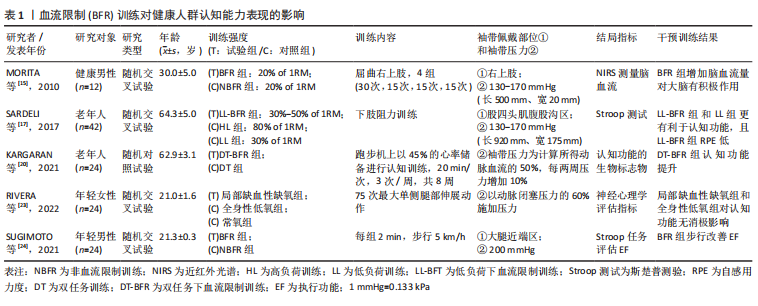

目前研究者主要通过评定相对压力下感知运动(rate of perceived exertion,RPE)和疼痛等级来表征感知反应。个体的感知反应一方面可能影响参与者动机,决定是否坚持运动计划;另一方面又预示着其对知觉-运动能力的影响。在以往研究中,进行高强度训练所带来的知觉反应升高常被认为是个体参与运动障碍的因素[27],因此明确血流限制训练对知觉反应的影响对进一步开展研究至关重要。多数研究者认为相较于传统的高强度阻力训练,血流限制训练会引起更少的RPE评分[28-30],但也有研究者持相反观点,认为血流限制训练同高强度训练一样导致高知觉反应[31]。还有研究者发现,为期较长的低负荷下血流限制训练运动干预减轻了运动期间的感知运动反应,这可能是机体对血流限制训练的耐受性增加、痛觉减退和内源性的疼痛调节机制发挥了作用[32]。此外,采用不同材质、不同围度(长或宽)的血流限制袖带进行训练后发现知觉反应程度相似,这说明袖带材质和运动过程中的感知等级不太可能成为应用更高压力的限制因素[33],且不同的血流限制训练干预方式如持续性或间歇性血流限制训练都诱导了相似的代谢反应,对知觉反应的影响不具有显著性差异[34]。然而,迄今为止只有极少数研究对长期进行血流限制训练运动是否可以减轻知觉反应的升高方面进行了研究,未来还需要更进一步的研究来确定长期血流限制训练运动对知觉反应的缓解作用,以及制定行之有效的策略来面对由血流限制训练所引起的感知反应升高的负面影响,增强运动依从性。 综上所述,血流限制训练可对健康人群的认知能力产生积极影响,其效果与传统高强度抗阻训练相当。血流限制训练具有的轻负荷特性使其能够尽可能产生更低的躯体关节压力,降低肌肉、关节的损伤风险。此外,与低强度抗阻训练相比,血流限制训练又有持续时间短、自感疲劳度低等优势。可见,血流限制训练在提供有效的临床训练刺激的基础上,可有助于改善不同人群的运动依从性,提高训练有效率。 2.1.2 血流限制训练对患者群认知能力的影响 近年来,随着血流限制训练技术的不断发展,研究者逐渐致力于将血流限制训练应用在患病后认知功能损伤的治疗中。脑震荡或轻度创伤性脑损伤对公众健康构成了巨大威胁,有10%-30%的患者在数周至数年内仍存在认知功能障碍,这种现象被称为持续性脑震荡后症状 [35]。传统的脑震荡治疗建议患者在受伤后立即休息,同时放弃身体和认知恢复,这将可能加速身体功能和认知表现衰退,而实施渐进性体力活动计划是避免产生此类不良后果的有效方法[36]。有研究在观察血流限制训练联合中等强度间歇训练对持续性脑震荡后症状患者的影响后发现,联合训练更为稳定、有效地缓解患者的脑震荡后症状,且与只进行中等强度间歇训练的对照组相比,试验组患者情绪和睡眠质量改善更为明显[37]。除持续性脑震荡后症状之外,脑卒中后抑郁也可能导致患者认知和精神方面的慢性后果,严重影响生活质量。研究者将24例缺血性脑卒中患者随机分为低强度阻力训练组、血流限制训练-低强度阻力训练组和高强度阻力训练组,依次进行坐位下拉、坐位肩推和坐位胸推及坐位腿踢运动,并在训练结束后迅速采集患者肘静脉血测定脑源性神经营养因子和血管内皮生长因子水平[38],结果发现,在同等运动强度下,使用血流限制可以增加脑卒中后抑郁患者外周神经营养因子水平,较低训练强度即可产生与高强度训练相似的运动效果,且训练时患者主观体力感较低、运动依从性较高,产生这种效应可能与血流受限后升高的乳酸水平有关[39]。 综上所述,血流限制训练改善患者群认知能力的的短期效果已得到验证,对于难以坚持高强度、长时间的运动锻炼的患者而言,血流限制训练是降低运动损伤,提高运动依从性的安全、有效的方式[40]。但目前有关血流限制训练对不同人群认知能力影响的研究相对较少,未来仍需更多大样本、多中心的随机对照试验来进一步评估长期应用的效果,同时还应注重调查和试验方法的细节处理,如认知评估的时间、持续追踪随访受试者在停止锻炼后进行了何种活动等。此外,还应探索不同的认知任务、运动剂量、受试者,拓宽神经影像测量技术,以更好地说明血流限制训练对不同人群认知能力的影响,使其应用发展更为成熟。"

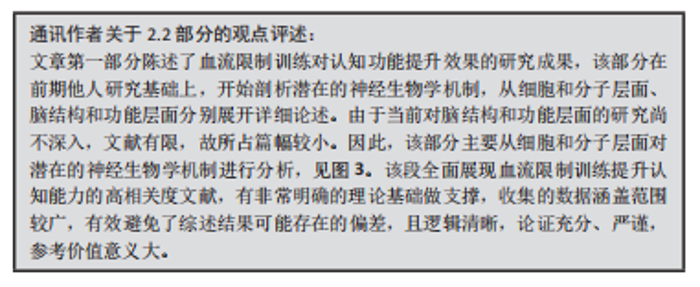
2.2 血流限制训练对认知能力影响的神经生物学机制研究进展 2.2.1 血流限制训练对认知能力影响的细胞和分子机制 血流限制训练通过对肢端应用低氧刺激进而引起大脑中氧气缺乏,这在一定程度上被认为是触发积极神经适应的关键性因素[41-42],这意味着应用血流限制训练进行训练,可能能够诱导人体释放更多积极神经适应激素。研究表明,与不使用血流限制训练的同等强度运动相比,联合血流限制训练的运动能使与认知功能改善相关的生物活性分子水平显著提高,其中包括胰岛素样生长因子1、生长激素、血管内皮生长因子、脑源性神经营养因子、乳酸、缺氧诱导因子1α、过氧化物酶体增殖活化受体γ辅助活化因子1α(peroxisome proliferator-activated receptor γ coactiva-tor-1,PGC1-α)和去甲肾上腺素。 胰岛素样生长因子1是胰岛素多肽家族的一员。运动时,胰岛素样生长因子1主要由肝脏和肌肉等组织表达,循环中的胰岛素样生长因子1可以穿过血脑屏障进入大脑。脑组织胰岛素样生长因子1水平的升高与神经祖细胞的增殖、分化、存活和迁移、轴突生长、树突成熟及突触生成密切相关,而胰岛素样生长因子1缺乏将导致与认知功能障碍相关的神经系统疾病的发生和发展。研究发现,相较于不使用血流限制训练,2次/d的低强度抗阻运动结合血流限制训练的长期干预能够使胰岛素样生长因子1的基础水平更高。由此推测血流限制训练可通过提高胰岛素样生长因子1的表达水平从而促进认知功能。与胰岛素样生长因子1功能相似的生长激素,目前也已被证明可在多种情况下改善认知功能水平,其主要由脑垂体分泌,是肽激素的一种。生长激素主要存在于大脑皮质、下丘脑、小脑和海马体等脑区,在促进神经系统的结构发育、神经元增殖分化、轴突树突生长、突触信号传递、神经保护和再生和认知与行为等发挥重要的调节作用[43]。血清生长激素缺乏与认知功能障碍之间关联密切,生长激素水平的提高与认知能力改善有关。研究发现,血流限制训练联合步行训练可以增强生长激素的合成代谢水平[44],因此血流限制训练可能是提高生长激素水平从而促进认知的有效策略。血管内皮生长因子是神经发生过程必不可少的调控因子,在神经系统中扮演重要角色。研究显示,增加脑部血管内皮生长因子的基因表达量,能够促使神经发生;近一步研究结果同样表明,血管内皮生长因子有助于增加海马组织的血管生成,可为神经细胞提供丰富的血氧供应[45]。由此可见,血管内皮生长因子作为一种血管生成调节因子,其水平降低与认知功能障碍相关联。血管内皮生长因子参与血管生成,推测血管生成因子(如血清血管内皮生长因子)的减少可能与认知障碍(如阿尔茨海默病)有关。总体上看,相较于不使用血流限制训练,低强度运动结合血流限制训练的干预可以促进血管内皮生长因子表达[28]。 此外,脑源性神经营养因子是神经营养因子中的一员,可作为突触可塑性的主要介质,与大脑皮质体积、神经发生和神经元活动关联密切,其表达量升高有利于认知功能改善,且可有效降低神经系统疾病的患病风险。乳酸对脑源性神经营养因子的产生和释放起到非常重要的作用[46],一方面,乳酸可以通过增强神经元中N-甲基-D-天冬氨酸受体(N-methyl-D-aspartate receptor,NMDA)的活性来促进神经可塑性基因脑源性神经营养因子的产生和表达;另一方面,乳酸可通过诱导Sirtuin1因子激活纤连蛋白Ⅲ型结构域 (FN3)上的含Ⅲ型纤连蛋白域蛋白5(FNDC5)-脑源性神经营养因子信号通路,进而诱导过氧化物酶体增殖物活化受体γ激活PGC-1因子,从而促进脑源性神经营养因子产生[47]。综上,乳酸与脑源性神经营养因子表达成正向关系,乳酸的增加可能会导致大脑中脑源性神经营养因子表达增加,进而增加某些大脑区域的神经元活动,从而增强相应区域的认知功能。研究发现,8周的DT联合血流限制训练可显著提高脑源性神经营养因子的静息水平[20]。研究证实,血流限制训练结合有氧运动或抗阻运动均能导致血乳酸水平的大幅度提高[48-49]。运动后血乳酸水平的提高与认知功能的改善有关。乳酸被认为是一种重要的信号分子,参与机体重要的代谢过程。外周表达的乳酸可以通过单羧酸转运蛋白的作用穿过血脑屏障进入脑组织,激活神经元的NMDA受体及其相关通路,上调突触可塑性基因的表达水平,从而促进长时程增强和记忆的形成。乳酸还可通过结合血脑屏障上的羟基羧酸受体1,促进脑组织血管内皮生长因子的表达和血管再生。此外,乳酸和外周脑源性神经营养因子变化密切相关,静息时输注乳酸后脑源性神经营养因子显示升高[46],表明血乳酸水平的提高还能够通过增加脑源性神经营养因子来改善认知。大量证据表明,与无血流限制训练的抗阻训练相比,应用血流限制训练进行抗阻训练后血乳酸浓度升高明显[50]。SUGIMOTO等[24]同样发现,在血流受限的情况下以5 km/h速度行走后血乳酸增加强于在没有血流受限的情况下行走时观察到的反应。 另外,缺氧诱导因子1α作为一种内活性核因子,可在缺氧状态下广泛存在于人体内。研究发现,缺氧诱导因子1α对低氧环境极为敏感,全身缺氧和局部缺氧都会提高转录因子水平,并且其可通过激活多种信号通路,参与脑组织缺血缺氧的病理生理过程[51]。缺氧诱导因子1α是适应氧稳态的主要调节因子,一方面具有神经保护作用,另一方面能够诱导脑组织血管内皮生长因子和胰岛素样生长因子1的增加,在系统和/或血流限制训练诱导时的升高对认知具有重要作用[52]。因此,缺氧诱导因子1α可能也是血流限制训练抗阻运动后神经认知适应的关键因素。PGC-1α是一种共转录因子,可介导骨骼肌中的线粒体生物发生,同时也在介导海马神经元内脑源性神经营养因子的增加中发挥重要作用[53]。PGC-1α可诱导产生与神经保护功能有关的调节因子,通过血液循环与大脑之间进行物质交换,从而实现对脑组织脑源性神经营养因子的表达调控,进而改善认知功能。现有研究表明,血流限制训练结合有氧运动或抗阻运动[54-55],与没有血流限制的相同运动相比,不仅能够增加骨骼肌PGC-1α mRNA的表达,还可以进一步提高PGC-1α的表达,也可以通过多条信号通路调节PGC-1α的活性。还有一种与认知功能水平相关的激素为去甲肾上腺素,与单独进行的同等强度运动相比,具有血流限制的有氧运动和抗阻运动已被证明可以增强去甲肾上腺素-觉醒系统[56-57]。去甲肾上腺素的合成和释放影响与执行能力相关的前额叶皮质的功能[58],其浓度的增加会刺激前额叶皮质和其他区域的α2A-肾上腺素受体,从而抑制钙-cAMP信号转导通路,导致突触输入的加强[59]。高浓度的去甲肾上腺素会刺激大脑中的α1-肾上腺素受体和β-肾上腺素受体。动物研究表明,α1-肾上腺素受体可以积极影响与简单任务相关的感觉运动皮质功能[60]。此外,去甲肾上腺素诱导的β-肾上腺素受体的刺激是启动大量细胞内信号级联的重要组成部分,该信号级联磷酸化cAMP反应元件结合蛋白,从而增强晚期长时程增强[61]。总的来说,当去甲肾上腺素的增加高于刺激α2A肾上腺素受体的水平,但低于刺激α1-和β-肾上腺素受体的水平时,血流限制运动可能会增强执行功能任务的表现。此外,当其增加高于刺激α1-和β-肾上腺素受体的水平时,血流限制运动可能不会增强执行功能任务的表现,但可能改善注意力、知觉和情景记忆。 2.2.2 血流限制训练对认知能力影响的结构机制 研究发现,与未使用血流限制训练的同等强度抗阻运动相比,在血流受限的急性抗阻运动后,皮质运动兴奋性显著增加,并在运动后60 min保持升高[8],且皮质运动区氧合血红蛋白水平升高,脑血流量更大。响应血流限制运动的更大的大脑兴奋性可能是由于Ⅲ和Ⅳ组传入纤维对运动皮质的感觉反馈增强。此外,在前额叶区域,与没有血流限制训练下的膝关节伸展运动相比,在有血流限制训练的膝关节伸展时观察到脱氧血红蛋白浓度更高,而氧合血红蛋白的增加减少[62]。一般来说,脱氧血红蛋白水平的降低和氧合血红蛋白水平的升高与皮质活动的增加有关。由于脱氧血红蛋白被认为比氧合血红蛋白受生理假象的影响更小,它可能是皮质活动的一个更好的代表,因此可以推测,在血流限制的情况下进行运动时,脱氧血红蛋白的显著减少可能表明皮质激活更高。 一般而言,运动锻炼后皮质活动水平较高(如大脑中氧合血红蛋白浓度较高)与认知能力的改善有关。据观察,在运动后认知能力有所改善的参与者在运动期间,与没有认知能力改善的参与者相比,其前额叶区域的皮质活动表现出更高的水平。在SARDELI等[17]的研究中发现,使用血流限制训练进行低负荷抗阻训练后Stroop测试表现增强,可能是由于前额叶皮质氧化血红蛋白水平升高所致,然而目前关于血流限制训练在结构和功能层面的研究还相对较少,未来应增加其对脑结构与功能的影响研究,更进一步剖析潜在的神经生物学机制。"
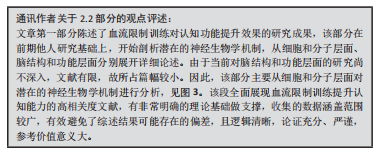
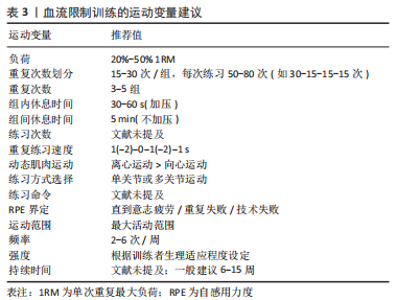
2.3 血流限制训练干预认知功能的策略研究 2.3.1 训练参与者的选择 运动方案的制定应充分考虑性别、遗传等个体因素对认知能力提升效果的影响及可能存在的神经生物学表达过程。BARHA等[63]研究发现性别差异是影响实施血流限制训练对认知能力干预效果的关键因素,尽管当前研究对性别调节现象产生的原因尚不清楚,但女性在认知功能提升方面常显示比同一基线水平的男性获益更多,这可能与运动诱导产生胰岛素样生长因子1和血管内皮生长因子等神经营养因子的水平存在性别差异有关[64]。另一个可能影响血流限制训练对认知能力交互作用的因素是参与者的基因特征[65],通过匹配与个体基因特征更相适应的血流限制训练计划,可以诱导更佳的认知能力提升效果[66]。然而当前研究仍没有充足的证据精确评估血流限制训练方案中个体基因型对测试结果的影响,因此未来有必要对这一领域进行更进一步的研究,提高相关干预效率。此外,研究者也应考量和测试“基线研究假设”,该假设指出,与训练结果的力量增益相比,在训练前或训练后通过评估如握力和/或膝关节伸肌力量的基线值更加适合作为评判长期健康测试结果的标志[67]。因此,与大脑健康增益有关的脑容量、认知功能等的基线值也应该被考虑在内。 2.3.2 袖带压力的调节变量 袖带压力作为血流限制训练诱导机体产生局部缺氧效果进而影响大脑认知能力提升的关键,应使静脉汇集于静脉池而不发生动脉闭塞,因此袖带压力必须低于动脉闭塞压力[68]。到目前为止,袖带压力的设置还没有统一的标准,研究者通常使用机体收缩压的130%、比动脉闭塞压低10 mmHg和约50%的动脉闭塞压[69],但最有效的袖带压力仍有待确定,且在具体实施过程中应注意以下各种调节变量对袖带压力的影响。充气袖带和弹性袖带是两种较为常见的加压袖带,BUCHNER等[70]研究发现袖带材质不同,血流受限情况也有所不同[71];除了袖带的材料外,加压带的宽度选择在训练时对于认知能力的提升效果也有很大影响。在血流限制训练中可选用的袖带宽度大多为5.0-14.0 cm,其中以7.0-8.0 cm较为常用[72]。也有研究者发现同等袖带压力下,宽袖带比窄袖带更能限制动脉血流[73],且受试者较多主观选择窄袖带进行训练,这表明窄袖带可能会增加训练依从性[74]。总之,宽袖带因具有受力面积更大、所需压力更小、降低肢体感觉减退、减少血管损伤风险等优势而在训练中更受到实施者青睐。一般情况下,充气袖带加压至40%-80%的肢体闭塞压与弹性袖带拉至初长度的10%-20%对血流量的限制程度相似[75],但需要注意的是压力太低可能阻碍血流限制训练诱导积极的认知功能生理和功能适应,压力过高同样可能会产生不良反应,且在训练中应单独测定上肢和下肢的袖带压力。还有报道称,压力训练方案例如采用间歇性或连续性压力训练时所引起的血流受限程度可能有所不同[68],有些则发现两者可诱导相似的积极生理反应[76]。此外,不同的血流限制系统,如使用自动压力控制或手动手持式压力控制系统时所测得的人体在运动和休息状态下的压力也会不同[77]。 因此,袖带压力的调节变量对于实施有效的血流限制训练并达到预设的生理反应是至关重要的,为了运用血流限制训练并引起认知相关的神经生理适应,应选择个性化的袖带压力并充分考虑调节变量与袖带压力之间的关系。 2.3.3 运动因素的确定 压力值和阻力负荷的确定是血流限制训练提升认知能力方案的重点环节,训练方式、训练量、持续时间、间歇时间和训练频率等的选择也是影响神经功能和生理适应的重要因素。到目前为止,只有以下因素被考虑并推荐于血流限制训练的认知功能增强,见表3。"
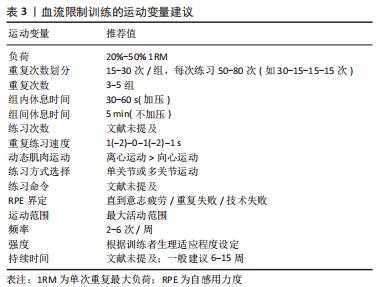

在血流限制训练中,不适的训练负荷常会引起运动损伤,研究者普遍认为低强度即以20%-50% 1RM的阻力值进行训练可以促进认知能力提升[78],且每周为期两三次的血流限制训练即可达到提升效果[79]。在训练过程中,对于同一功能的肌肉组织而言,一般以3-5组的重复次数为宜,每组单一动作的练习总次数为50-80次,可以按30,15,15,15次的组内间歇形式进行次数安排。既往的元分析发现,在训练次数和间隔时间的选择上一般认为30-60 s的组内间歇时间最为合适[80],组间休息时间过长或过短都有可能影响预期的训练效果[81]。需要注意的是,在加压训练期间所设置的组间休息时间通常较短,目的是为了尽可能减少人体在血流受限过程中产生不适反应。且每次训练时长不固定,可根据被试者的情况作出适当调整,一般以10-20 min作用为宜。此外,一般建议被试者持续进行为期6-15周的中长期血流限制训练干预[82],以此获得更佳的干预效果。 2.3.4 血流限制训练干预认知功能的效果评价 血流限制训练可在多个层面影响认知表现,因此在运动干预方案设计和分析中应综合考虑多种指标,以厘清血流限制训练与认知功能之间的复杂关系。基于细胞和分子水平,神经化学标志物如胰岛素样生长因子1、生长激素、血管内皮生长因子、血乳酸及脑源性神经营养因子水平的变化应作为纳入指标;基于结构和功能水平,应合理应用神经影像学模式,如近红外脑功能成像(functional near-infrared spectroscopy,fNIRS)、脑电图(electroencephalogram,EEG)、脑功能磁共振成像(functional magnetic resonance imaging,fMRI)或组合模式[83],以了解血流限制训练所引起的脑结构和功能的改变,其中fNIRS和EEG测量系统因其可以在训练过程中评估认知能力,所以可能与血流限制训练的适配度更高。此外,还可使用标准化的认知功能测试如Stroop测试、Sternberg测试和Eriksen Flanker测试等观察大脑功能性改变[84];基于个体社会/行为情绪水平,可运用感觉觉醒量表、感知运动评分、视觉模拟量表和SF-36量表等充分评估个体生活质量,阐明血流限制训练提升认知进而影响社会情绪状态的调节效应。"

| [1] BUCKNER RL. Memory and executive function in aging and AD: multiple factors that cause decline and reserve factors that compensate. Neuron. 2004;44(1):195-208. [2] COLCOMBE S, ERICKSON K, KIM J, et al. Aerobic exercise training increases brain volume in aging humans. J Gerontol A Biol Sci Med Sci. 2006;61(11): 1166-1170. [3] 蒋长好,陈婷婷,石长地.身体活动对老年人认知和脑功能的影响[J].中国老年学杂志,2015,35(12):3445-3447. [4] HEROLD F, TORPEL A, SCHEGA L, et al. Functional and/or structural brain changes in response to resistance exercises and resistance training lead to cognitive improvements–a systematic review. Eur Rev Aging Phys A. 2019;16(1):1-33. [5] SAEZ DE ASTEASU ML, MARTINEZ-VELILLA N, ZAMBOM-FERRARESI F, et al. Role of physical exercise on cognitive function in healthy older adults: asystematic review of randomized clinical trials. Ageing Res Rev. 2017;37(5):117-134. [6] TEGTBUR U, HAUFE S, BUSSE MW. Application and effects of blood flow restriction training. Unfallchirurg. 2020;123(3):170-175. [7] LORENZ DS, BAILEY L, WILK KE, et al. Blood flow restriction training. J Athl Training. 2021;56(9):937-944. [8] BRANDNER CR, WARMINGTON SA, KIDGELL DJ. Corticomotor excitability is increased following an acute bout of blood flow restriction resistance exercise. Front Hum Neurosci. 2015;13(7):1-10. [9] 毛宁,刘书芳,卫星.血流限制训练在老年人中的应用研究进展[J].中国老年保健学,2020,18(6):117-121. [10] SHINOHARA M, KOUZAKI M, YOSHIHISA T, et al. Efficacy of tourniquet ischemia for strength training with low resistance. Eur J Appl Physiol. 1997; 77(1):189-191. [11] PATTERSON SD, HUGHES L, WARMINGTON S, et al. Blood flow restriction exercise: considerations of methodology, application, and safety. Front Physiol. 2019;15(10):533-547. [12] LOENNEKE J, ABE T, WILSON J, et al. Blood flow restriction: an evidence based progressive model. Acta Physiol Hung. 2012;99(3):235-250. [13] FARUP J, DE PAOLI F, BJERG K, et al. Blood flow restricted and traditional resistance training performed to fatigue produce equal muscle hypertrophy. Scand J Med Sci Sports. 2015;25(6):754-763. [14] MOUSER JG, MATTOCKS KT, BUCKNER SL, et al. High-pressure blood flow restriction with very low load resistance training results in peripheral vascular adaptations similar to heavy resistance training. Physiol Meas. 2019;40(3):35-54. [15] MORITA T, FUKUDA T, KIKUCHI H, et al. Effects of blood flow restriction on cerebral blood flow during a single arm-curl resistance exercise. Igrras. 2010;6(1):9-12. [16] PERIANEZ JA, LUBRINI G, GARCIA-GUTIERREZ A, et al. Construct validity of the stroop color-word test: influence of speed of visual search, verbal fluency, working memory, cognitive flexibility, and conflict monitoring. Arch Clin Neuropsychol. 2021;36(1):99-111. [17] SAIDELI AV, FERREIRA MLV, SANTOS LC, et al. Low-load resistance exercise improves cognitive function in older adults. Rev Bras Med Esporte. 2018; 24(2):125-129. [18] PRODEL E, BALANOS GM, BRAZ ID, et al. Muscle metaboreflex and cerebral blood flow regulation in humans: implications for exercise with blood flow restriction. Am J Physiol Heart Circ Physiol. 2016;310(9):1201-1209. [19] TAIT JL, DUCKHAM RL, MILTE CM, et al. Influence of sequential vs. simultaneous dual-task exercise training on cognitive function in older adults. Front Aging Neurosci. 2017;9(7):368-377. [20] KARGARAN A, ABEDINPOUR A, SAADATMEHR Z, et al. Effects of dual-task training with blood flow restriction on cognitive functions, muscle quality, and circulatory biomarkers in elderly women. Physiol Behav. 2021;7(24): 113-121. [21] TAKEUCHI H, MAGISTRO D, KOTOZAKI Y, et al. Effects of simultaneously performed dual-task training with aerobic exercise and working memory training on cognitive functions and neural systems in the elderly. Neural Plast. 2020. doi:10.1155/2020/3859824. [22] SCHWARZ M, URHAUSEN A, SCHWARZ L, et al. Cardiocirculatory and metabolic responses at different walking intensities. Brit J Sport Med. 2006; 40(1):64-67. [23] RIVERA PM, PROOOE CE, BELTRAN E, et al. Acute effects of local ischemic hypoxia and systemic hypoxemia on neuromuscular and cognitive function. High Alt Med Biol. 2022;23(1):18-25. [24] SUGIMOTO T, SUGA T, TOMOO K, et al. Blood flow restriction improves executive function after walking. Med Sci Sports Exerc. 2021;53(1):131-138. [25] VAN HALL G, STOMSTAD M, RASMUSSEN P, et al. Blood lactate is an important energy source for the human brain. J Cerebr Blood F Met. 2009; 29(6):1121-1129. [26] TSUKAMOTO H, SUGA T, TAKENAKA S, et al. Repeated high-intensity interval exercise shortens the positive effect on executive function during post-exercise recovery in healthy young males. Physiol Behav. 2016;160:26-34. [27] EKKEKAKIS P, PARFITT G, PETRUZZELLO SJ. The pleasure and displeasure people feel when they exercise at different intensities. Sports Med. 2011; 41(8):641-671. [28] DU X, CHEN W, ZHAN N, et al. The effects of low-intensity resistance training with or without blood flow restriction on serum BDNF, VEGF and perception in patients with post-stroke depression. Neuro Endocrinol Lett. 2021;42(4):229-235. [29] MARTIN-HERNANDEZ J, RUIZ-AGUADO J, HERRERO AJ, et al. Adaptation of perceptual responses to low-load blood flow restriction training. J Strength Cond Res. 2017;31(3):765-772. [30] TEIXEIRA EL, PAINELLI VS, SCHOENFELD BJ, et al. Perceptual and neuromuscular responses adapt similarly between high-load resistance training and low-load resistance training with blood flow restriction. J Strength Cond Res. 2022;36(9):2410-2416. [31] SUGA T, DORA K, MOK E, et al. Exercise adherence‐related perceptual responses to low‐load blood flow restriction resistance exercise in young adults: a pilot study. Physiol Rep. 2021;9(23):15-29. [32] HUGHES L, PATTERSON SD. The effect of blood flow restriction exercise on exercise-induced hypoalgesia and endogenous opioid and endocannabinoid mechanisms of pain modulation. J Appl Physiol. 2020;128(4):914-924. [33] LONENEKE JP, KIM D, MOUSER JG, et al. Are there perceptual differences to varying levels of blood flow restriction?. Physiol Behav. 2016;157:277-280. [34] FREITAS EDS, MILLER RM, HEISHMAN AD, et al. Perceptual responses to continuous versus intermittent blood flow restriction exercise: a randomized controlled trial. Physiol Behav. 2019;21(2):11-37. [35] BAKER JG, FREITAS MS, LEDDY JJ, et al. Return to full functioning after graded exercise assessment and progressive exercise treatment of postconcussion syndrome. Rehabil Res Pract. 2012;5(7):1-7. [36] GIZA CC, KUTCHER JS, ASHWAL S, et al. Summary of evidence-based guideline update: evaluation and management of concussion in sports: report of the Guideline Development Subcommittee of the American Academy of Neurology. Neurology. 2013;80(24):2250-2257. [37] WU YN, STARK C, GRAVEL J, et al. Effects of interval-training exercise on people with persistent post-concussive symptoms less than one year: a pilot study. J Neurotrauma. 2020;69(15):1-26. [38] HADIDI NN, HUNA WAGNER RL, LINDQUIST R. Nonpharmacological treatments for post-stroke depression: an integrative review of the literature. Res Gerontol Nurs. 2017;10(4):182-195. [39] MAGISTRETTI PJ, ALLAMAN I. Lactate in the brain: from metabolic end-product to signalling molecule. Nat Rev Neurosci. 2018;19(4):235-249. [40] LOENEKE JP, WILSON JM, WILSON GJ, et al. Potential safety issues with blood flow restriction training. Scand J Med Sci Sports. 2011;21(4):510-518. [41] NAVARRETE-OPAZO A, MITCHELL GS. Therapeutic potential of intermittent hypoxia: a matter of dose. Am J Physiol Regul Integr Comp Physiol. 2014; 307(10):1181-1197. [42] RICHARDSON C, HOGAN AM, BUCKS RS, et al. Neurophysiological evidence for cognitive and brain functional adaptation in adolescents living at high altitude. Clin Neurophysiol. 2011;122(9):1726-1734. [43] MARTINEZ-MORENO CG, CALDERON-VALLEJO D, HARVEY S, et al. Growth hormone (GH) and gonadotropin-releasing hormone (GnRH) in the central nervous system: a potential neurological combinatory therapy? Int J Mol Sci. 2018;19(2):375-395. [44] ABE T, KEARNS CF, SATO Y. Muscle size and strength are increased following walk training with restricted venous blood flow from the leg muscle, Kaatsu-walk training. J Appl Physiol. 2006;100(5):1460-1466. [45] HAN J, CALVO CF, KANG TH, et al. Vascular endothelial growth factor receptor 3 controls neural stem cell activation in mice and humans. Cell Rep. 2015;10(7):1158-1172. [46] SCHIIFFER T, SCHULTE S, SPERLICH B, et al. Lactate infusion at rest increases BDNF blood concentration in humans. Neurosci Lett. 2011;488(3):234-237. [47] El HAYEK L, KHALIFEH M, ZIBARA V, et al. Lactate mediates the effects of exercise on learning and memory through SIRT1-dependent activation of hippocampal brain-derived neurotrophic factor (BDNF). J Neurosci. 2019;39(13):2369-2382. [48] THOMAS HJ, SCOTT BR, PEIFFER JJ. Acute physiological responses to low-intensity blood flow restriction cycling. J Sci Med Sport. 2018;21(9):969-974. [49] KIM D, LOENNEKE JP, Ye X, et al. Low‐load resistance training with low relative pressure produces muscular changes similar to high‐load resistance training. Muscle Nerve. 2017;56(6):126-133. [50] WILSON JM, LOWERY RP, Joy JM, et al. Practical blood flow restriction training increases acute determinants of hypertrophy without increasing indices of muscle damage. J Strength Cond Res. 2013;27(11):3068-3075. [51] SHIBATA T, YAMAGATA H, UCHIDA S, et al. The alteration of hypoxia inducible factor-1 (HIF-1) and its target genes in mood disorder patients. Prog Neuropsychopharmacol Biol Psychiatry. 2013;43:222-229. [52] SLOMIANY MG, ROSENZWEIG SA. Hypoxia-inducible factor-1-dependent and -independent regulation of insulin-like growth factor-1-stimulated vascular endothelial growth factor secretion. J Pharmacol Exp Ther. 2006;318(2): 666-675. [53] BERGERSEN LH. Lactate transport and signaling in the brain: potential therapeutic targets and roles in body-Brain interaction. J Cereb Blood Flow Metab. 2015;35(2):176-185. [54] CHRISTIANSEN D, MURPHY RM, BANGSBO J, et al. Increased FXYD1 and PGC-1αmRNA after blood flow-restricted running is related to fibre type-specific AMPK signalling and oxidative stress in human muscle. Acta Physiol (Oxf). 2018;223(2):13-69. [55] FERGUSON RA, HUNT JEA, LEWIS MP, et al. The acute angiogenic signalling response to low-load resistance exercise with blood flow restriction. Eur J Sport Sci. 2018;18(3):397-406. [56] OZAKI H, LOENNEKE JP, Abe T. Blood flow‐restricted walking in older women: does the acute hormonal response associate with muscle hypertrophy? Clin Physiol Funct Imaging. 2017;37(4):379-383. [57] LOENNEKE J, WILSON JM, THIEBAUD RS, et al. β2 Adrenoceptor signaling-induced muscle hypertrophy from blood flow restriction: is there evidence? Horm Metab Res. 2012;44(7):489-493. [58] MCMORRIS T. Developing the catecholamines hypothesis for the acute exercise-cognition interaction in humans: lessons from animal studies. Physiol Behav. 2016;165:291-299. [59] ARNSTEN AFT, WANG MJ, PASPALAS CD. Neuromodulation of thought: flexibilities and vulnerabilities in prefrontal cortical network synapses. Neuron. 2012;76(1):223-239. [60] MCMORRIS T, TURNER A, HALE BJ, et al. Beyond the catecholamines hypothesis for an acute exercise–cognition interaction: a neurochemical perspective. Elsevier Inc. 2016;65-103. [61] LOPRINZI PD. An integrated model of acute exercise on memory function. Med Hypotheses. 2019;126:51-59. [62] GANESAN G, COTTER JA, REULAND W, et al. Effect of blood flow restriction on tissue oxygenation during knee extension. Med Sci Sports Exerc. 2015; 47(1):185-193. [63] BARHA CK, DAVIS JC, FALCK RS, et al. Sex differences in exercise efficacy to improve cognition: a systematic review and meta-analysis of randomized controlled trials in older humans. Front Neuroendocrinol. 2017;46:71-85. [64] BARHA CK, LIU-AMBROSE T. Exercise and the aging brain: considerations for sex differences. Brain Plast. 2018;4(1):53-63. [65] BARHA CK, GALEA LA, NAGAMATSU LS, et al. Personalising exercise recommendations for brain health: considerations and future directions. Br J Sports Med. 2017;51(8):636-639. [66] JONES N, KIELY J, SURACI B, et al. A genetic-based algorithm for personalized resistance training. Biol Sport. 2016;33(2):117-126. [67] BUCKNER SL, DANKEL SJ, MOUSER JG, et al. Chasing the top quartile of cross-sectional data: is it possible with resistance training? Med Hypotheses. 2017;108:63-68. [68] SCOTT BR, LOENNEKE JP, SLATTERY KM, et al. Exercise with blood flow restriction: an updated evidence-based approach for enhanced muscular development. Sports Med. 2015;45(3):313-325. [69] BRANDNER CR, KIDGELL DJ, WARMINGTON SA. Unilateral bicep curl hemodynamics: low‐pressure continuous vs high‐pressure intermittent blood flow restriction. Scand J Med Sci Sports. 2015;25(6):770-777. [70] BUCKNER SL, DANKEL SJ, COUNTS BR, et al. Influence of cuff material on blood flow restriction stimulus in the upper body. J Physiol Sci. 2017;67(1): 207-215. [71] LOENNEKE JP, THIEBAUD RS, FAHS CA, et al. Effect of cuff type on arterial occlusion. Clin Physiol Funct Imaging. 2013;33(4):325-327. [72] BIELITZKI R, BEHRENDT T, BEHRENS M, et al. Current techniques used for practical blood flow restriction training: a systematic review. J Strength Cond Res. 2021;35(10):2936-2951. [73] MOUSER JG, DANKEL SJ, JESSEE MB, et al. A tale of three cuffs: the hemodynamics of blood flow restriction. Eur J Appl Physiol. 2017;117(7): 1493-1499. [74] SPITZ RW, CHATAKONDI RN, BELL ZW, et al. Blood flow restriction exercise: effects of sex, cuff width, and cuff pressure on perceived lower body discomfort. Percept Mot Skills. 2021;128(1):353-374. [75] ABE T, MOUSER JG, DANKEL SJ, et al. A method to standardize the blood flow restriction pressure by an elastic cuff. Scand J Med Sci Sports. 2019; 29(3):329-335. [76] FREITAS EDS, MILLER RM, HEISHMAN AD, et al. Acute physiological responses to resistance exercise with continuous versus intermittent blood flow restriction: a randomized controlled trial. Front Physiol. 2020. doi:10.3389/fphys.2020.00132. [77] HUGHES L, ROSENBLATT B, GISSANE C, et al. Interface pressure, perceptual, and mean arterial pressure responses to different blood flow restriction systems. Cand J Med Sci Sports. 2018;28(7):1757-1765. [78] LIXANDRAO ME, UGRINOWITSCH C, BERTON R, et al. Magnitude of muscle strength and mass adaptations between high-load resistance training versus low-load resistance training associated with blood-flow restriction: a systematic review and meta-analysis. Sports Med. 2018;48(2):361-378. [79] SCOTT BR, PEIFFER JJ, GOODS PSR. The effects of supplementary low-load blood flow restriction training on morphological and performance-based adaptations in team sport athlete. J Strength Cond Res. 2017;31(8):2147-2154. [80] LOENNEKE JP, BALAPUR A, THROWER AD, et al. The perceptual responses to occluded exercise. Int J Sports Med. 2011;32(3):181-184. [81] LOENNEKE JP, PUJIOL TJ. KAATSU: rational for application in Astronauts. Hippokratia. 2010;14(3):224. [82] 苏荣海.加压训练促进肌适能的实践应用及生理机制的研究[J].中国康复医学杂志,2019,34(7):856-861. [83] ROOKS CR, THOM NJ, MCCULLY KK, et al. Effects of incremental exercise on cerebral oxygenation measured by near-infrared spectroscopy: a systematic review. Prog Neurobiol. 2010;92(2):134-150. [84] HSIEH SS, CHANG YK, HUNG TM, et al. The effects of acute resistance exercise on young and older males’ working memory. Psychol Sport Exerc. 2016;22:286-293. |
| [1] | Pan Weimin, Wang Bing, Han Yabing, Li Ting, Song Jiaqi, Qin Huasheng, Liu Yang. Effects of blood flow restriction training on muscle strength, muscle mass and physical performance in older adults: a Meta-analysis [J]. Chinese Journal of Tissue Engineering Research, 2023, 27(5): 805-812. |
| [2] | Liang Xiao, Zhao Panchao, Li Jiahui, Ji Zhongqiu, Jiang Guiping. Gait and biomechanical characteristics of lower limbs in multi-task walking of 4-6-year-old children [J]. Chinese Journal of Tissue Engineering Research, 2023, 27(4): 505-512. |
| [3] | Lei Senlin, Zhang Minghui, Ma Chunlian, Gao Weifeng, Xia Xiaoyan, Dong Kunwei. Muscle effect, dose-effect relationship, and physiological mechanism of KAATSU-resistance training [J]. Chinese Journal of Tissue Engineering Research, 2023, 27(26): 4254-4264. |
| [4] | Li Zhongshan, Bai Shi, Liu Jie, Yang Tieli, Zou Yuqi, Kong Weiqian, Li Wei, Zhang Qinyang, Chen Song, Che Tongtong, Li Zhiyuan, Guan Rongxin, Wang Chunlu. Maintenance and attenuation trajectory of increased muscle strength after exposure to short-term low-frequency pulsed magnetic field via activation of classical transient receptor potential vanilloid-1 [J]. Chinese Journal of Tissue Engineering Research, 2023, 27(23): 3721-3727. |
| [5] | Song Cuirong, Chen Tongzhen, Liu Meixiao, Zhang Haifeng. Simulated analysis of influence of walking step length on lower limb muscle strength in the elderly [J]. Chinese Journal of Tissue Engineering Research, 2023, 27(22): 3486-3491. |
| [6] | Peng Zifu, Guo Xiangying, Fang Hongbo, He Yimin, Jiang Ning. Exercise intervention improves hippocampal cognitive function by regulating insulin-like growth factor 1 [J]. Chinese Journal of Tissue Engineering Research, 2023, 27(17): 2729-2737. |
| [7] | Liu Xiuqi, Chen Fang, Zhong Hehe, Xiong Huazhang, Lyu Guoqing, Wu Shuhong, Liu Yi. Partial peroneus longus tendon reconstruction in the treatment of posterolateral complex injury of the knee joint [J]. Chinese Journal of Tissue Engineering Research, 2023, 27(13): 2093-2098. |
| [8] | Li Zhongshan, Wang Chunlu, Liu Jie, Yang Tieli, Kong Weiqian, Li Wei, Zhang Qinyang, Chen Song, Che Tongtong, Li Zhiyuan, Guan Rongxin, Bai Shi. Effects of short-term low-frequency pulsed electrical magnetic field-induced classical transient receptor potential channel 1 on maximum voluntary contraction and strength endurance of the biceps brachii [J]. Chinese Journal of Tissue Engineering Research, 2023, 27(11): 1796-1804. |
| [9] | Wei Xing, Liu Shufang, Mao Ning. Roles and values of blood flow restriction training in the rehabilitation of knee joint diseases [J]. Chinese Journal of Tissue Engineering Research, 2022, 26(5): 774-779. |
| [10] | Liu Yiyi, Qiu Junqiang, Yi Longyan, Zhou Cailiang. Effect of resistance training on interleukin-6 and C-reactive protein in middle-age and elderly people: a Meta-analysis [J]. Chinese Journal of Tissue Engineering Research, 2022, 26(5): 804-812. |
| [11] | Xiao Youding, Gao Qianjin, Wang Erli. Skeletal muscle function and exercise regulating cognitive function of the older adults [J]. Chinese Journal of Tissue Engineering Research, 2022, 26(33): 5400-5406. |
| [12] | Zhao Junguo, Chen Xin, Jiang Ruohan, Guo Ying, Gao Bo. Effects of metformin on cognitive dysfunction in preeclampsia rats [J]. Chinese Journal of Tissue Engineering Research, 2022, 26(29): 4651-4657. |
| [13] | Yang Yi, Wang Kun, Liu Hengxu, Zhang Tingran, Lu Wenyun, Chen Peijie, Luo Jiong. Aerobic exercise improves the cognitive function of elderly patients with mild cognitive impairment [J]. Chinese Journal of Tissue Engineering Research, 2022, 26(29): 4716-4722. |
| [14] | Zheng Wei, Sun Libing, Xiong Yingzhe, Zhang Yichi, You Jing, Huang Wenqi, Guo Yanhua, Liu Hongjun. Effect of eccentric strengthening on hamstring strength: a Meta-analysis [J]. Chinese Journal of Tissue Engineering Research, 2022, 26(29): 4749-4756. |
| [15] | Yang Jinxin, Wang Kun, Zhao Jing, Chen Peijie, Zhang Tingran, Lu Wenyun, Luo Jiong. Effects of aerobic exercise intervention on synaptic plasticity in Alzheimer’s disease patients [J]. Chinese Journal of Tissue Engineering Research, 2022, 26(26): 4216-4223. |
| Viewed | ||||||
|
Full text |
|
|||||
|
Abstract |
|
|||||


